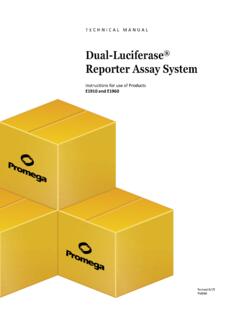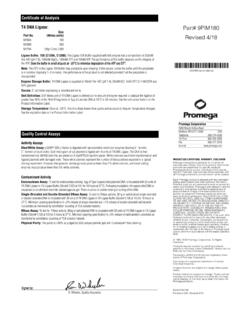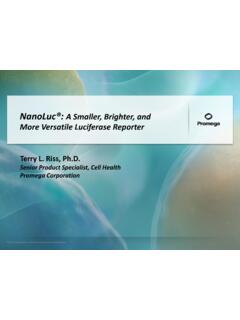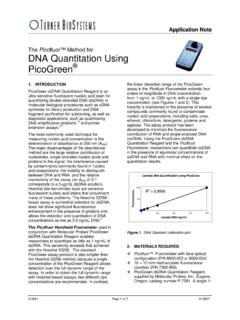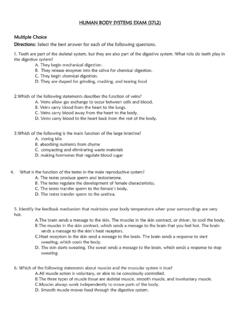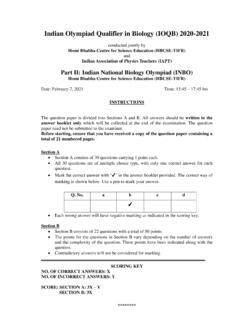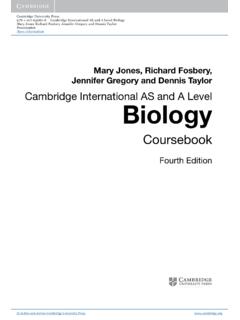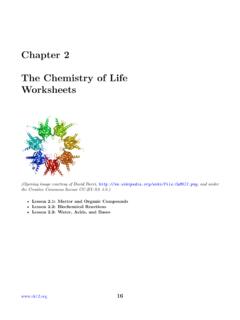Transcription of pGEM -T and pGEM -T Easy Vector Systems - Promega
1 Revised 10/21 TM042pGEM -T and pGEM -T Easy Vector SystemsInstructions for Use of Products A1360, A1380, A3600 and A3610 TECHNICAL MANUALAll technical literature is available at: Visit the web site to verify that you are using the most current version of this Technical Manual. E-mail Promega Technical Services if you have questions on use of this system: Corporation 2800 Woods Hollow Road Madison, WI 53711-5399 USA Toll Free in USA 800-356-9526 608-274-4330 Fax 608-277-2516 TM042 Revised 10/21pGEM -T and pGEM -T Easy Vector Systems 1. Introduction .. Vector Features .. Important Considerations for Successful T- Vector Cloning ..2 2. Product Components and Storage Conditions ..3 3. Protocol for Ligations Using the pGEM -T and pGEM -T Easy Vectors and the 2X Rapid Ligation Buffer .. Ligation Protocol .. Optimizing Insert: Vector Molar Ratios ..5 4.
2 Transformations Using the pGEM -T and pGEM -T Easy Vector Ligation Reactions .. Transformation Protocol .. Example of Transformation Efficiency Calculation .. Screening Transformants for Inserts ..8 5. pGEM -T and pGEM -T Easy Vector Sequences, Multi-Cloning Sites and Circle Maps .. Sequence and Multi-Cloning Site of the pGEM -T Vector .. pGEM -T Vector Map and Sequence Reference Points .. Sequence and Multi-Cloning Site of the pGEM -T Easy Vector .. pGEM -T Easy Vector Map and Sequence Reference Points ..11 6. General Considerations for PCR Cloning .. PCR Product Purity .. Properties of Various Thermostable Polymerases .. Cloning Blunt-Ended PCR Products ..13 7. Experimental Controls ..15 8. 9. References ..2010. Appendix .. pGEM -T Vector Restriction Enzyme Sites .. pGEM -T Easy Vector Restriction Enzyme Sites .. Composition of Buffers and Solutions.
3 Related Products .. Summary of Promega Corporation 2800 Woods Hollow Road Madison, WI 53711-5399 USA Toll Free in USA 800-356-9526 608-274-4330 Fax 608-277-2516TM042 Revised 10/21 Vector FeaturesT-Overhangs for Easy PCR Cloning: The pGEM -T and pGEM -T Easy Vectors are linearized vectors with a single 3 -terminal thymidine at both ends. The T-overhangs at the insertion site greatly improve the efficiency of ligation of PCR products by preventing recircularization of the Vector and providing a compatible overhang for PCR products generated by certain thermostable polymerases (1,2).Blue/White Selection of Recombinants: The pGEM -T and pGEM -T Easy Vectors are high-copy-number vectors containing T7 and SP6 RNA polymerase promoters flanking a multiple cloning region within the -peptide coding region of the enzyme -galactosidase. Insertional inactivation of the -peptide allows identification of recombinants by blue/white screening on indicator of Restriction Sites for Release of Insert: Both the pGEM -T and pGEM -T Easy Vectors contain numerous restriction sites within the multiple cloning region.
4 The pGEM -T Easy Vector multiple cloning region is flanked by recognition sites for the restriction enzymes EcoRI, BstZI and NotI, providing three single-enzyme digestions for release of the insert. The pGEM -T Vector cloning region is flanked by recognition sites for the enzyme BstZI. Alternatively, a double-digestion may be used to release the insert from either Ligation: The pGEM -T and pGEM -T Easy Vector Systems are supplied with 2X Rapid Ligation Buffer. Ligation reactions using this buffer may be incubated for 1 hour at room temperature. The incubation period may be extended to increase the number of colonies after transformation. Generally, an overnight incubation at 4 C produces the maximum number of Important Considerations for Successful T- Vector CloningAvoid introduction of nucleases, which may degrade the T-overhangs on the Vector . Use only the T4 DNA Ligase provided with the system, as this has been tested for minimal exonuclease activity.
5 Use sterile, nuclease-free water in your ligation high-efficiency competent cells ( 1 108cfu/ g DNA) for transformations. The ligation of fragments with a single-base overhang can be inefficient, so it is essential to use cells with a transformation efficiency of at least 1 108cfu/ g DNA in order to obtain a reasonable number of colonies. However, use of super high-efficiency competent cells ( , XL10 Gold Cells) may result in a higher background of blue exposure of your PCR product to shortwave UV light to avoid formation of pyrimidine dimers. Use a glass plate between the gel and UV source. If possible, only visualize the PCR product with a long-wave UV Corporation 2800 Woods Hollow Road Madison, WI 53711-5399 USA Toll Free in USA 800-356-9526 608-274-4330 Fax 608-277-2516 TM042 Revised 10/212. Product Components and Storage ConditionsPRODUCT SIZE CAT.
6 #pGEM -T Vector System I 20 reactions A3600 Includes: g pGEM -T Vector (50ng/ l) 12 l Control Insert DNA (4ng/ l) 100u T4 DNA Ligase 200 l 2X Rapid Ligation Buffer, T4 DNA LigasePRODUCT SIZE CAT.#pGEM -T Vector System II 20 reactions A3610 Includes: g pGEM -T Vector (50ng/ l) 12 l Control Insert DNA (4ng/ l) 100u T4 DNA Ligase 200 l 2X Rapid Ligation Buffer, T4 DNA Ligase JM109 Competent Cells, High Efficiency (6 200 l)PRODUCT SIZE CAT.#pGEM -T Easy Vector System I 20 reactions A1360 Includes: g pGEM -T Easy Vector (50ng/ l) 12 l Control Insert DNA (4ng/ l) 100u T4 DNA Ligase 200 l 2X Rapid Ligation Buffer, T4 DNA LigasePRODUCT SIZE CAT.#pGEM -T Easy Vector System II 20 reactions A1380 Includes: g pGEM -T Easy Vector (50ng/ l) 12 l Control Insert DNA (4ng/ l) 100u T4 DNA Ligase 200 l 2X Rapid Ligation Buffer, T4 DNA Ligase JM109 Competent Cells, High Efficiency (6 200 l)Storage Conditions: For Cat.
7 # A3610, A1380, store the Competent Cells at 70 C. Store all other components at 20 Promega Corporation 2800 Woods Hollow Road Madison, WI 53711-5399 USA Toll Free in USA 800-356-9526 608-274-4330 Fax 608-277-2516TM042 Revised 10/21 Protocol for Ligations Using the pGEM -T and pGEM -T Easy Vectors and the 2X Rapid Ligation Ligation Protocol1. Briefly centrifuge the pGEM -T or pGEM -T Easy Vector and Control Insert DNA tubes to collect the contents at the bottom of the Set up ligation reactions as described below. Note: Use tubes known to have low DNA-binding capacity ( , VWR Cat.# 20170-310). Vortex the 2X Rapid Ligation Buffer vigorously before each Mix the reactions by pipetting. Incubate the reactions for 1 hour at room temperature. Alternatively, if the maximum number of transformants is required, incubate the reactions overnight at 4 ComponentStandard ReactionPositive ControlBackground Control2X Rapid Ligation Buffer, T4 DNA Ligase5 l5 l5 lpGEM -T or pGEM -T Easy Vector (50ng)1 l1 l1 lPCR productX l* Control Insert DNA 2 l T4 DNA Ligase (3 Weiss units/ l)1 l1 l1 lnuclease-free water to a final volume of10 l10 l10 l*Molar ratio of PCR product: Vector may require :1.
8 Use only the T4 DNA Ligase supplied with this system to perform pGEM -T and pGEM -T Easy Vector ligations. Other commercial preparations of T4 DNA ligase may contain exonuclease activities that may remove the terminal deoxythymidines from the 2X Rapid Ligation Buffer contains ATP, which degrades during temperature fluctuations. Avoid multiple freeze-thaw cycles and exposure to frequent temperature changes by making single-use aliquots of the Longer incubation times will increase the number of transformants. Generally, incubation overnight at 4 C will produce the maximum number of Corporation 2800 Woods Hollow Road Madison, WI 53711-5399 USA Toll Free in USA 800-356-9526 608-274-4330 Fax 608-277-2516 TM042 Revised 10/214. An aliquot of the PCR reaction should be analyzed on an agarose gel before use in the ligation reaction to verify that the reaction produced the desired product.
9 The PCR product to be ligated can be gel-purified or purified directly from the PCR amplification using the Wizard SV Gel and PCR Clean-Up System (Cat.# A9281). Clean-up of reactions prior to ligation is recommended to remove primer dimers or other undesired reaction products, and to improve ligation efficiency. Exposure of PCR products to shortwave ultraviolet light should be minimized in order to avoid the formation of pyrimidine Optimizing Insert: Vector Molar RatiosThe pGEM -T and pGEM -T Easy Vector Systems have been optimized using a 1:1 molar ratio of the Control Insert DNA to the vectors. However, ratios of 8:1 to 1:8 have been used successfully. If initial experiments with your PCR product are suboptimal, ratio optimization may be necessary. Ratios from 3:1 to 1:3 provide good initial parameters. The concentration of PCR product should be estimated by comparison to DNA mass standards on a gel or by using a fluorescent assay (3).
10 The pGEM -T and pGEM -T Easy Vectors are approximately 3kb and are supplied at 50ng/ l. To calculate the appropriate amount of PCR product (insert) to include in the ligation reaction, use the following of Vector kb size of insert insert: Vector molar ratio = ng of insertkb size of vectorExample of insert: Vector ratio calculation:How much PCR product should be added to a ligation in which 50ng of Vector will be used if a 3:1 insert: Vector molar ratio is desired?50ng Vector insert 3 = 25ng vector1 Using the same parameters for a 1:1 insert: Vector molar ratio, of a insert would be : The Biomath calculator ( ) can be used to determine the amount of insert DNA needed. The pGEM -T Vector size is 3000bp and the pGEM -T Easy Vector size is 3, Promega Corporation 2800 Woods Hollow Road Madison, WI 53711-5399 USA Toll Free in USA 800-356-9526 608-274-4330 Fax 608-277-2516TM042 Revised 10/21 Transformations Using the pGEM -T and pGEM -T Easy Vector Ligation ReactionsUse high-efficiency competent cells ( 1 108cfu/ g DNA) for transformations.
